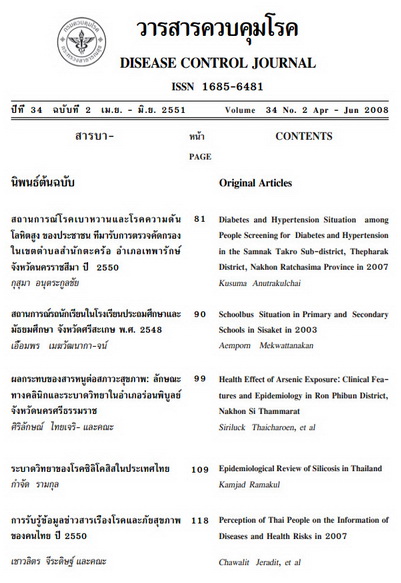Access to Condom through Condom Vending Machine in Thailand: Development and Community Participation
Keywords:
Access to Condom, Condom Vending Machine, Community ParticipationAbstract
At present, trend of unsafe casual sex, particularly among youth, had increased, causing an increasing trend of sexually transmitted infections (STIs) cases and risk to HIV infections. Accessibility to condom was limited due to high price of condom and shyness to buy. Department of Disease Control launched two projects, in which parts of the projects were to develop system to increase condom accessibility through condom vending machine (CVM). The projects was first conducted nationwide in 2004. The objectives of this study were to gather data and synthesize knowledge of such development, to document projects' outputs and outcomes and to recommend further development. Data were collected from provincial projects' reports, site visits and meetings, survey of satisfaction among customers, survey among provincial health staff and CVM producers or importers, and reviews of related documents. It was found that the development was conducted in preparation, implementation and expansion phases. The results, divided into 4 aspects as follows: 1. Expansion of CVM. There were limited numbers of CVMs available before 2004. However, up to 2007, 7,967 CVMs were installed directly or indirectly as lead by the strategy developed by the projects, supported by various organizations. Price of condoms selling through CVMs was 5-10 Baht per 2-3 pieces. 2. Development of the machine model. Initial model was imported, plastic-made, and used with non-electricity mechanism. Several models have been developed later. Most were produced locally, made from metal, able to contain higher number of condom boxes (up to 96 boxes/machine), with choices of electricity and non-electricity used mechanism. 3. Development of CVM management. There were 4 managerial models observed from the projects development. CVM management can be performed 1) health staff, 2) community, 3) NGOs and 4) health staff and community. 4. Monitoring and evaluation. Evaluation showed median condoms sale were 46.5 and 31.0 pieces/machine-month (m-m) in urban, and 40.0 and 32.5 pieces/m-m in rural in 2005 and 2006 respectively. Suitable installment places were hotel, dormitory, hospital, health center, department store and cinema. 89.8% of customers reported satisfied with CVM service. Obstacles found were misplacement of CVMs, coins stolen, unsatisfied maintenance service and CVM management problems. This study revealed a successful promotion of condom accessibility through CVM leading to higher rate of condom used and began-to-decline trend of STIs. Further development should gear towards ownership of local administrations and community participation to sustain CVM management, with closed monitoring and evaluation.
Downloads
References
2. กลุ่มโรคติดต่อทางเพศสัมพันธ์ สำนักโรคเอดส์ วัณโรค และโรคติดต่อทางเพศสัมพันธ์. การปฏิบัติงานควบคุมโรคติดต่อทางเพศสัมพันธ์ปีงบประมาณ 2548. กรุงเทพมหานคร: โรงพิมพ์การศาสนา, มิถุนายน 2549.
3. กลุ่มโรคติดต่อทางเพศสัมพันธ์ สำนักโรคเอดส์ วัณโรค และโรคติดต่อทางเพศสัมพันธ์. การปฏิบัติงานควบคุมโรคติดต่อทางเพศสัมพันธ์ปีงบประมาณ 2549. กรุงเทพมหานคร: โรงพิมพ์ สำนักงานพระพุทธศาสนาแห่งชาติ, พฤษภาคม 2550
4. กลุ่มงานป้องกันทางพฤติกรรมและชุมชน สำนักโรคเอดส์ วัณโรค และโรคติดต่อทางเพศสัมพันธ์ร่วมกับมหาวิทยาลัยหอการค้าไทย. รายงานโครงการวิจัยความคิดเห็นเรื่องเครื่องจำหน่ายถุงยางอนามัยแบบหยอดเหรียญ. นนทบุรี: สำนักโรคเอดส์ วัณโรค และโรคติดต่อทางเพศสัมพันธ์ กรมควบคุมโรค กระทรวงสาธารณสุข, มิถุนายน 2546. ISBN 974-297-236-2.
5. สำนักโรคเอดส์ วัณโรค และโรคติดต่อทางเพศสัมพันธ์ กรมควบคุมโรค กระทรวงสาธารณสุข. โครงการเร่งรัดส่งเสริมการใช้ถุงยางอนามัย. กรุงเทพฯ: โครงการโรคเอดส์แห่งสหประชาชาติ, ธันวาคม 2547. ISBN 974-297-369-5.
6. ผจงศิลป์ เพิงมาก, รัชนี สุขบุญสังข์, ถั้น พงษ์ศรี, สุพักตร์ วาณิชเสนี. พฤติกรรมการมีเพศสัมพันธ์การใช้ถุงยางอนามัย การรับรู้ความเสี่ยง และการป้องกันการติดเชื้อเอ็ชไอวี/เอดส์ ของเยาวชนผู้เสพยาบ้าที่เข้ารับการบำบัดรักษา ณ หน่วยบำบัดยาเสพติดแห่งหนึ่งในพื้นที่ภาคใต้ ของประเทศไทย. วารสารโรคเอดส์ 2548; 17: 20-31.
7. นิตยา ระวังพาล, ศิริพร วงศ์ชัย, สุรสิงห์ วิศรุตรัตน. ถุงยางอนามัยกับวัยเยาวชน: มิติการมีเพศสัมพันธ์ก่อนวัยพร้อม (Abstract ID: DP0059). นำเสนอในการสัมมนาระดับชาติเรื่องโรคเอดส์ ครั้งที่ 10 วันที่ 13-15 กรกฎาคม 2548 ที่มหาวิทยาลัยราชภัฏสวนดุสิต และมหาวิทยาลัย ราชภัฏสวนสุนันทา กรุงเทพมหานคร.
8. Rojanapithayakorn W, Hanenberg R. The 100% Condom Program in Thailand. AIDS 1996, 10(1): 1-7.
9. อนุพงศ์ ชิตวรากร. Sexually Transmitted Diseases. กรุงเทพมหานคร: บริษัทโฮลิสติก พับลิชชิ่ง จำกัด, 2543. ISBN 974-7898-60-8
10. กลุ่มโรคติดต่อทางเพศสัมพันธ์ สำนักโรคเอดส์ วัณโรค และโรคติดต่อทางเพศสัมพันธ์. ปริมาณและมูลค่าการจัดซื้อถุงยางอนามัย. กรุงเทพฯ: สำนักโรคเอดส์ วัณโรค และโรคติดต่อทางเพศสัมพันธ์, 2548.
11. สำนักโรคเอดส์ วัณโรค และโรคติดต่อทางเพศสัมพันธ์. สรุปมติการประชุมคณะกรรมการแห่งชาติว่าด้วยการป้องกันและแก้ไขปัญหาเอดส์ครั้งที่ 2/2545 วันที่ 5 มิถุนายน 2545. นนทบุรี: สำนักโรคเอดส์ วัณโรค และโรคติดต่อทางเพศสัมพันธ์, 2545.
12. กระทรวงมหาดไทย. หนังสือที่ มท. 02147/ว2773 ลงวันที่ 11 ตุลาคม 2545 เรื่องขอความสนับสนุนในการติดตั้งเครื่องจำหน่ายถุงยางอนามัยแบบหยอดเหรียญ. กรุงเทพฯ: กระทรวงมหาดไทย, 2545.
13. นุชนารถ แก้วดำเกิง, ชีวนันท์ เลิศพิริยสุวัฒน์, วินิดา ชวนางกูร, ชูศักดิ์ สุคนธมาน, เครือทิพย์ จันทรธานีวัฒน์, นงเยาว์ จันทร์ทองคำ และคณะ. การพัฒนารูปแบบการส่งเสริมการเข้าถึงถุงยางอนามัย โดยเครื่องจำหน่ายถุงยางอนามัยแบบหยอดเหรียญ. วารสารโรคเอดส์ 2550; 19(2): 73-84.
14. นุชนารถ แก้วดำเกิง, ชีวนันท์ เลิศพิริยสุวัฒน์, สมบัติ แทนประเสริฐสุข, วินิดา ชวนางกูร, ชูศักดิ์ สุคนธมาน, นงเยาว์ จันทร์ทองคำ. การศึกษาความรู้ในการป้องกันโรคเอดส์ พฤติกรรมทางเพศ และความพึงพอใจต่อเครื่องจำหน่ายถุงยางอนามัย. วารสารโรคเอดส์ 2550; 19(4): 193-205.
15. Chamratrithirong A, Kittisuksathit S, Podhisita C, Isarabhakdi P, Sabaiying M. National Sexual Behavior Survey of Thailand 2006. Nakhon Pathom: Institute for Population and Social Research, Mahidol University, 2007. ISBN: 978-
974-11-0876-3.
16. CDCynergy. Key Social Marketing Concepts. http://www.orau.gov/cdcynergy/demo/content/activeinformation/ SOC_key_sm_concepts.htm. เข้าดูเมื่อ 17 มกราคม 2551.
17. กระทรวงมหาดไทย. หนังสือที่ มท 0211.3/ว3908 ลงวันที่ 7 พฤศจิกายน 2549 เรื่อง ขอความร่วมมือส่งเสริมการใช้ถุงยางอนามัยเพื่อการป้องกันโรคติดต่อทางเพศสัมพันธ์และโรคเอดส์. กรุงเทพฯ: กระทรวงมหาดไทย, 2549.
18. ชีวนันท์ เลิศพิริยสุวัฒน์, เครือทิพย์ จันทรธานีวัฒน์, นุชนารถ แก้วดำเกิง, สมบัติ แทนประเสริฐสุข. การสำรวจความคิดเห็นต่อคุณลักษณะเฉพาะของเครื่องจำหน่ายถุงยางอนามัยแบบหยอดเหรียญที่เหมาะสมกับการบริการในชุมชนของประเทศไทย. วารสารโรคเอดส์ 2548; 17(4): 218-230.
19. สุชิน เหลืองอุทัยรัตน์. การศึกษาการดำเนินงานกล่องจำหน่ายถุงยางอนามัยในจังหวัดเลย ปี พ.ศ.2547. วารสารโรคเอดส์ 2548; 17(3): 147-154.
20. สถาบันพัฒนาการสาธารณสุขอาเซียน มหาวิทยาลัยมหิดล และกองควบคุมโรคเอดส์ สำนักอนามัย กรุงเทพมหานคร. การเฝ้าระวังพฤติกรรมที่สัมพันธ์กับการติดเชื้อเอชไอวีในประชากร 6 กลุ่มเป้าหมายพื้นที่กรุงเทพมหานคร ปี 2550. นครปฐม: สถาบันพัฒนาการสาธารณสุขอาเซียน มหาวิทยาลัยมหิดล, 2550. ISBN: 978-974-11-0866-4.
21. มัติกา ศรีพวงทอง. ความรู้ทัศนคติของผู้ใช้บริการถุงยาง อนามัยแบบหยอดเหรียญในเขตเมือง จังหวัดศรีสะเกษ พ.ศ. 2546. ใน: ผลการวิเคราะห์สถานการณ์โรคเอดส์ประเทศไทย 2546 เล่ม 1. นนทบุรี: สำนักระบาดวิทยา กรมควบคุมโรค, 2546. ISBN: 974-291-212-5.
22. Ministry of Foreign Affairs of Thailand and UNDP Thailand. Comprehensive Response to HIV/AIDS Prevention and Care: Thailand-Africa Partnership (Nairobi, Kenya 22-24 June 2005). Bangkok: Keen Publishing (Thailand) Co., Ltd., 2006. ISBN: 974-94231-3-5.
23. Ministry of Foreign Affairs of Thailand and UNDP Thailand. Comprehensive Response to HIV/AIDS Prevention and Care: Thailand-Africa Partnership (Gaborone, Botswana 16-18 November 2005). Bangkok: Keen Publishing (Thailand) Co., Ltd., 2006. ISBN: 974-94231-2-7.
24. The Nation. Kingdom to help fight HIV/AIDS in Africa (ตีพิมพ์ วันที่ 4 กรกฎาคม 2548). http://www.nationmulti media.com/search/page.arcview.php?clid=3&id=117896. เข้าดูเมื่อ 28 มกราคม 2551.
Downloads
Published
How to Cite
Issue
Section
License
Articles published in the Disease Control Journal are considered as academic work, research or analysis of the personal opinion of the authors, not the opinion of the Thailand Department of Disease Control or editorial team. The authors must be responsible for their articles.






